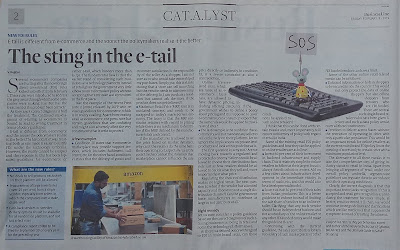The latest buzz word that I am asked about in various forums is Omni Channel and how a retailer can become one. In many cases the understanding of what Omni Channel Retailing is very hazy. In a few cases this is considered to represent a seamless shopper experience across the physical, online and mobile access points of any retailer.
Some of the successful examples of Omni Channel retailing being showcased is more about such a seamless experience. For example, Apple has linked their mobile app to their store and vice versa. The app can be used to book service appointments, order products, etc., and the integration helps the shopper get alerts when they are near a store, receive targeted messages, etc. Carrefour has simplified this by enabling the shoppers to place online orders by voice or scan. Once the order is complete, the same can be delivered or picked up from a store. Several other retailers are experimenting with technology such as electronic tags, Near Field Communication (NFC), etc.
However I feel that all these are more about a superior multi channel approach to retailing. Multi channel retailing is when both online and offline options can be accessed by the shoppers and there is some extent of integration between the two. Omni Channel would ideally be the next step forward where such integration between offline and online access becomes seamless.
The key word in this context is - seamless and that cannot be limited to only the information gathering/ sharing or shopper interface. Shopping is after all about purchasing physical products and unless the physical dimension of shopping becomes seamlessly integrated across physical, online and mobile.
Omni channel retail should be defined by the acronym BAFARA. This stands for Buy Anywhere, Fulfill Anywhere and Return/ Replace Anywhere.
Most of the current examples tend to focus on the “BAFA” part whereas this is an incomplete value proposition from a shopper’s perceptive. One point of view is that the extensive analytics and shopper profiling that is done would enable retailers to deliver the exact requirements of any shopper. The logic is that, therefore the need for return or replacement would not exist. Hence the focus on “BAFA” is good enough for creating a Omni Channel offering.
As someone who understands shopper behavior and expectations I do not think that this would be acceptable to shoppers. Whether they actually return or replace any product purchased or not, they would like to have that option available to them at any given time.
An ideal Omni Channel experience offering BAFARA would play out somewhat like this;
I am leaving office and suddenly remember that I was supposed to purchase a few items as guests are expected at home in the evening. Thankful for having remembered I place an order for these items on the mobile app and select the option for a store pick up. Since I have paid for the same, these are available for immediate pick up and I don’t even have to park my car. I reach home with the purchases only to find that a few products need to be returned. Since I am logged into my home computer, I access my shopping history online and place a request for the return of these products. Since I am travelling the next day, I select the pickup from home option for the return.
I bought the items on my mobile, picked it up from the store and would be returning it from my home. BAFARA essentially means the convenience of being able to shop in this manner with various permutation and combinations. That would truly be Omni Channel retail.
Sounds simple enough but it is not so and the challenges start mounting if one were to truly deliver the BAFARA value proposition.
The primary challenge and to some extent becomes a constraint is with regard to the organizational structure and management mindset. In a scenario where offline and online channels are treated as separate business units with independent deliverables as also responsibilities, they become competitors. This is a significant bottleneck in the journey to becoming an Omni Channel retailer.
There are several other strategic as also operational challenges which have constrained most of the Omni Channel initiatives to remain restricted to BAFA instead of offering BAFARA. I shall detail the key challenge with some ideas with regard to the same in another post.
In summary all I would say is that Omni Channel is not about technology and data alone. It is equally about physical products and owning the shopper experience, end to end. This holistic experience cannot be restricted to BAFA and must encompass BAFARA. Till that is clearly and very well defined as also executed, experiments in the Omni Channel space would remain just experiments.













